Tools to Reconnect USB Device Without Unplugging
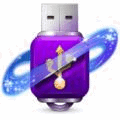
Ejecting a USB flash drive using the “Safely Remove Hardware” option in Windows can prevent file corruption. However, once ejected, there’s no easy way to remount the drive. Below are five methods to remount your USB device without needing to unplug it.
1. DevEject
DevEject is a simple software that can be configured to replace the Safely Remove Hardware and Eject Media in Windows. It has the ability to eject, unplug, detect files in use that prevent the device from ejecting, and hotkey support.
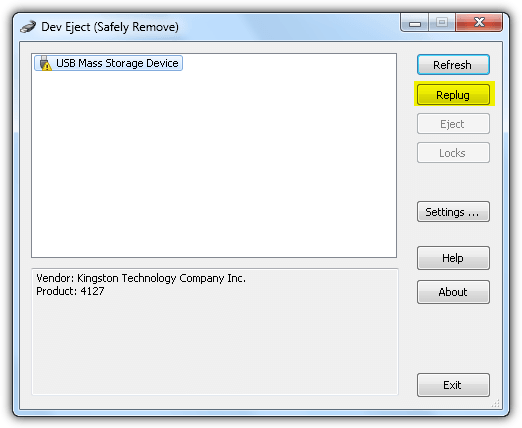
To remount an ejected USB drive, simply select the device from Dev Eject and click on the Replug button which we’ve highlighted in the screenshot above. The replug feature worked perfectly when tested in Windows XP and 7 but not in Windows 8.1 as the program kept on crashing. Although Dev Eject comes in a setup installer, you can actually copy the program folder to another computer and use it without reinstalling.
2. USB Safely Remove
USB Safely Remove is an extended USB device manager. It is able to completely replace the native “Safely Remove Hardware Icon” in Windows and offer a lot more functionality such as renaming/stopping/hiding a device, program autorun on connect/disconnect, command line and keyboard shortcut keys support, investigate why a device cannot be stopped/ejected, and most importantly returning a device back without reconnecting it (unplug and reinsert). USB Safely Remove can even detect and notify you if other devices will be affected when returning the device back.
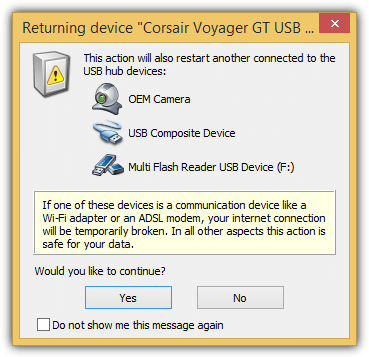
Although USB Safely Remove is a shareware claiming that you can use all the features for the first 30 days. The program can still fully work after expiration though, a registration reminder notification will be displayed with a 30 second countdown before you can continue the popup.
3. Zentimo
Zentimo is the successor of USB Safely Remove created by the same developers with the aim to be a Swiss army knife for the management of external storage devices. It has all the features found in USB Safely Remove plus a quick launch menu to easily launch portable applications, testing the speed of the drive, disabling Windows autorun, portable settings and TrueCrypt integration.
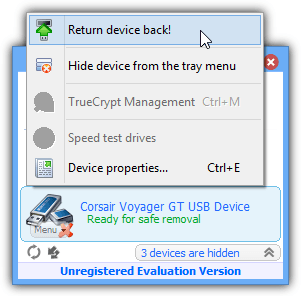
To return a stopped device back, simply click on the device that is marked with “Ready for safe removal” or you can also right click and select “Return device back!”. The development for both USB Safely Remove and Zentimo has slowed down a lot recently with no updates for a year but they do officially support Windows 8.
Zentimo is also a shareware and the trial limitation is exactly the same as USB Safely Remove where you can still continue using it even when it has expired.
4. Disable and Re-enable USB Mass Storage Device
This fourth method is a manual way of remounting an ejected USB device without relying on a third party software. When you’ve ejected a USB flash drive, the device icon will be shown with a yellow exclamation mark in Device Manager with the message saying “Windows cannot use this hardware device because it has been prepared for safe removal but it has not been removed from the computer (Code 47)”.
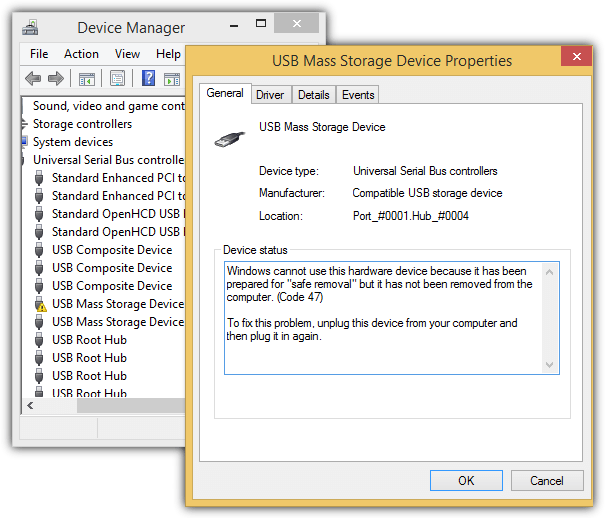
Tip: To access Device Manager, press WIN + Pause/Break keys to bring up System and click on Device Manager from the left pane.
For Windows XP, all you need to do is right click on the device, select Disable and click Yes to confirm. Right click on the device again, this time select Enable and you’ll notice that Windows will start to re-detect and remount the USB drive.
For Windows 8.1, do the same as above and make sure you click on No when prompted to restart your computer after selecting Enable. Repeat the steps of disabling and enabling the device one more time and again click on No when asked to restart. Amazingly Windows 8.1 remounts the ejected Drive after cycling the disable and enable twice. Strangely this method does not work on Windows 7.
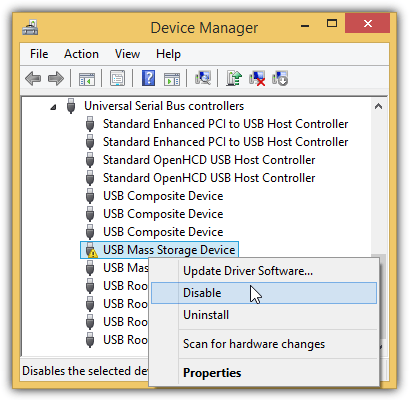
You can automate this task automatically using a batch file with devcon.exe. DevCon is a command line utility that can perform a number of actions such as enabling and disabling a device in Device Manager. You can download devcon.exe from here, extract and use the build (either 32-bit or 64-bit) according to your Windows architecture.
First you’ll need to find the Hardware ID of your USB flash drive from Device Manager. Double click on the USB Mass Storage Device, go to Details tab, and select Hardware IDs from the Property drop down menu. Note down the value of your USB device.
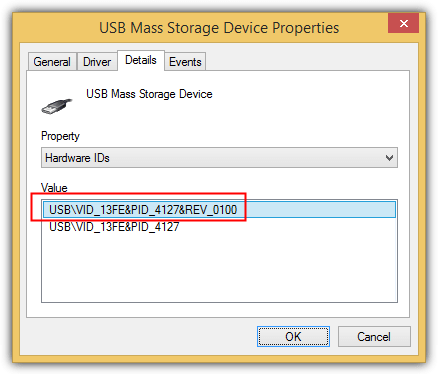
Copy the 4 lines below and paste it into Notepad. Replace the values of *Your_PARTIAL_HW_ID* according to your device’s hardware ID.
devcon disable *YOUR_PARTIAL_HW_ID*
devcon enable *YOUR_PARTIAL_HW_ID*
devcon disable *YOUR_PARTIAL_HW_ID*
devcon enable *YOUR_PARTIAL_HW_ID*
You can either enter full or partial hardware ID depending if you have another device with the same vendor ID. As you can see from the screenshot below, we used a wildcard on VID_13FE because we know that there is no other device with the hardware ID VID_13FE other than our USB flash drive.
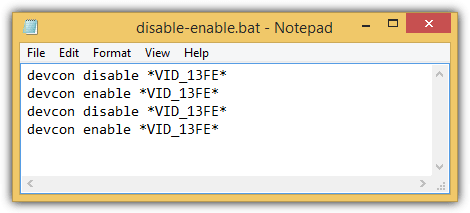
Place the batch file together with devcon.exe. Whenever you run the batch file, it will automatically enable and disable your USB device twice to force Windows 8.1 to remount your ejected USB flash drive.
5. Uninstall USB Root Hub
Uninstalling USB Root Hub and reinstalling it again can also trigger Windows to remount an ejected USB flash drive. The steps are quite similar to the fourth method and it works on Windows 7. First you need to eject the drive, then go to Device Manager by pressing WIN + Pause/Break keys and click on Device Manager at the left pane. Click on View menubar and select Devices by connection.
Locate the USB Mass Storage Device with a yellow exclamation mark, right click on the parent “USB Root Hub” and select Uninstall. If you’re using Windows 7, click on the Action menu bar and select “Scan for hardware changes”. This will force Windows to register and reinstall any USB devices under the USB Root Hub that you’ve uninstaller earlier. If you’re on Windows 8.1, Microsoft has made it so much easier because Windows will instantly remount your USB device after uninstalling the USB Root Hub.
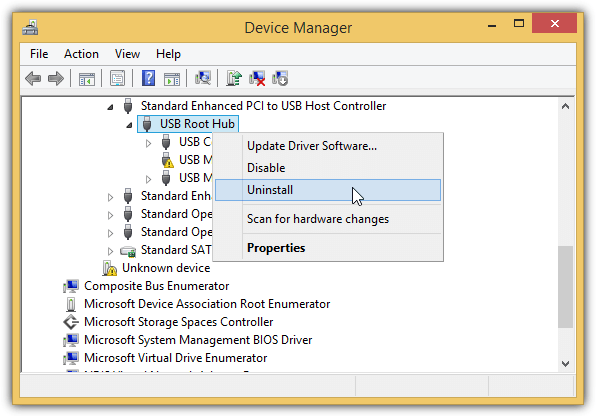
Unlike disabling and re-enabling a USB Mass Storage Device, you won’t be asked to restart your computer but if you have another device such as an ADSL modem connected to your USB port, then it might get disconnected when you uninstall the USB Root Hub. The devcon command is also much simpler because you don’t really need to identify the hardware ID that you want to uninstall. Use the command below:
devcon remove *root_hub20*
For Windows 7, you’ll need to add a second line to rescan for hardware changes.
devcon rescan
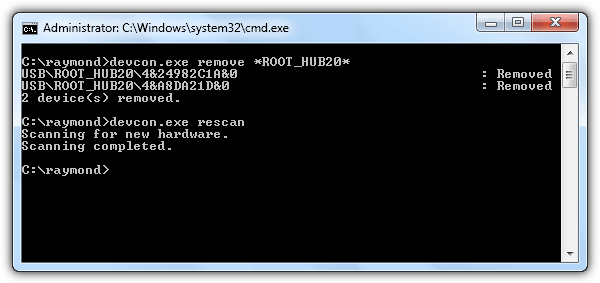
A ready made batch file to remove the USB Root Hub and rescan for hardware changes has been made available for you which can be downloaded from the link below. Simply download the package according to your Windows architecture.
Download Devcon Remove Rescan for 32-Bit | 64-Bit
Wrapping up
In a Windows operating system, it is a safe practice to always use the “Safely Remove Hardware and Eject Media” to eject a plugged in USB flash drive instead of directly pulling it out to prevent any opened files from being corrupted. Doing this will also trigger Windows to enable the dirty bit on the flash drive where Windows will automatically prompt to scan the drive for error the next time you plug it in. If Windows found corrupted files during check disk, it will simple convert them into .CHK files that can only be recovered via third party tools.
Although Windows provides a safe and convenient way to safely eject your USB flash drive, there are no options to easily remount or reconnect the ejected drive. It seems like the only way is to unplug the drive and reinsert it into the USB port for Windows to re-detect and re-mount the USB flash drive. This can be very troublesome if the device is connected to the USB port located at the rear of the computer.





User forum
38 messages